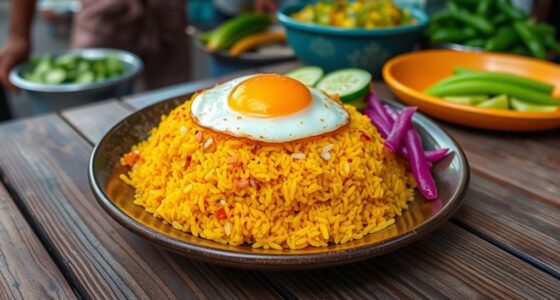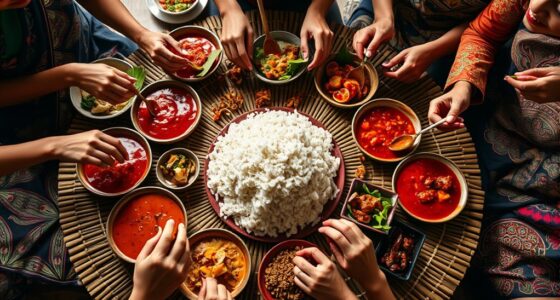Dutch-Indonesian fusion dishes from the colonial era, like rijsttafel and satay, still evoke centuries of shared history. These dishes blend local flavors with Dutch influences, using ingredients like spices, coconut, and turmeric that have stood the test of time. They symbolize the deep cultural exchange that shaped Dutch and Indonesian cuisines. If you’re curious about how these flavors continue to influence modern cooking, there’s more fascinating history to explore.
Key Takeaways
- Rijsttafel showcases Indonesian dishes served with rice, embodying Dutch-Indonesian culinary fusion from the colonial era.
- Dishes like satay and rendang reflect the blending of local ingredients and Dutch cooking techniques.
- Spices such as turmeric, nutmeg, and cloves introduced during trade remain central to modern fusion dishes.
- Colonial-era recipes integrated ingredients like coconut and chili, which continue to influence contemporary cuisine.
- The enduring popularity of these dishes symbolizes the deep cultural exchange and historical legacy of Dutch-Indonesian food.

Have you ever tasted the vibrant blend of Dutch and Indonesian flavors? If not, you’re missing out on a unique culinary journey that reflects centuries of history and cultural exchange. This fusion is rooted in the colonial era when the Dutch established a presence in Indonesia, bringing with them not only administrative control but also a rich culinary tradition that would shape the island’s food scene forever. During this period, colonial culinary practices blended local ingredients with Dutch techniques, creating dishes that still delight taste buds today. The spice trade played a pivotal role in this culinary evolution. As spices like cloves, nutmeg, and mace flowed into the region from distant lands, they became the backbone of many Indonesian dishes, and Dutch cooks eagerly adopted and adapted these flavors. This exchange resulted in a unique gastronomic identity that’s both vibrant and complex.
The Dutch colonial influence introduced ingredients and cooking methods that combined seamlessly with local traditions. For example, dishes like rijsttafel, which translates to “rice table,” epitomize this fusion. Originally a colonial banquet showcasing a variety of Indonesian dishes served with rice, rijsttafel exemplifies how Dutch and Indonesian cuisine intertwined. It’s a feast of flavors, textures, and aromas, heavily influenced by the spice trade that made these ingredients accessible and desirable. The colonial culinary legacy also includes dishes like satay, which was popularized during this period and remains a beloved street food across Indonesia and the Netherlands. These dishes reflect a shared history, where the Dutch embraced Indonesian ingredients such as coconut, chili, and turmeric, incorporating them into their own recipes.
You might notice that many of these colonial-era dishes have persisted over centuries, evolving into staples that are still enjoyed today. This endurance is no accident. It’s a tribute to how deeply these flavors and techniques have become embedded in both cultures. The spice trade’s impact was profound, facilitating the exchange of not only goods but also culinary ideas. It’s why Indonesian cuisine, with its bold, aromatic flavors, remains influential in Dutch kitchens and beyond. When you taste a dish like rendang or sate, you’re experiencing more than just a meal; you’re savoring a piece of history—an edible reminder of a time when global trade routes connected distant worlds through spices and shared culinary traditions.
Frequently Asked Questions
How Did Dutch Colonization Influence Indonesian Cuisine?
Dutch colonization greatly influenced Indonesian cuisine through colonial culinary exchanges. You can see this in dishes that blend local flavors with Dutch ingredients, like satay with peanut sauce or kroket snacks. The spice trade brought aromatic spices to Indonesia, enriching its culinary tradition. This fusion persists today, showcasing how colonial history shaped Indonesian food, creating a unique culinary identity that combines local tastes with colonial influences.
Are Dutch-Indonesian Fusion Dishes Popular Outside Indonesia?
Dutch-Indonesian fusion dishes have gained international popularity, especially among food enthusiasts enthusiastic to explore culinary fusion. You’ll find these dishes in global restaurants and food festivals, celebrated for their unique blend of flavors. Their enduring appeal lies in the rich history and diverse ingredients that make them stand out. So, if you’re into culinary fusion, you’ll likely enjoy exploring these colonial-era dishes that continue to delight worldwide palates.
What Are the Key Ingredients in Dutch-Indonesian Dishes?
Did you know that over 60% of Dutch-Indonesian dishes feature a unique mix of spice blends? You’ll find key ingredients like turmeric, coriander, and chili peppers, which bring vibrant flavors. These dishes often use cooking techniques such as frying and simmering, blending Dutch and Indonesian culinary traditions. The combination of aromatic spices and diverse techniques creates the rich, complex flavors that make these dishes unforgettable and enduring.
How Have These Fusion Recipes Evolved Over Time?
You’ll notice these fusion recipes have evolved through culinary adaptations and flavor innovations, blending traditional Dutch techniques with Indonesian spices and ingredients. Over time, cooks have experimented, adding new herbs, adjusting spice levels, and incorporating modern cooking methods. This ongoing evolution keeps the dishes vibrant and relevant, reflecting cultural exchange and creativity, while honoring their colonial-era roots. You can enjoy a rich tapestry of flavors that continue to transform and inspire.
Are There Modern Chefs Reinventing Dutch-Indonesian Cuisine Today?
You’ll be surprised to discover that contemporary chefs are reinventing Dutch-Indonesian cuisine through culinary innovation. They blend traditional flavors with modern techniques, creating exciting new dishes that honor history while appealing to today’s tastes. This coincidence of past and present fuels creativity, leading chefs to experiment with ingredients and presentation. As a result, Dutch-Indonesian fusion remains vibrant, evolving with each chef’s unique perspective and passion for cultural storytelling through food.
Conclusion
As you savor the rich flavors of Dutch-Indonesian dishes, you realize these recipes carry stories far beyond their ingredients. They whisper of history, cultural blending, and resilience—secrets waiting to be uncovered. Will you explore more of these timeless flavors and discover the deeper connections they hold? The journey into this fusion isn’t just about food; it’s about uncovering a shared past that still lingers, inviting you to taste its mysteries with every bite.








